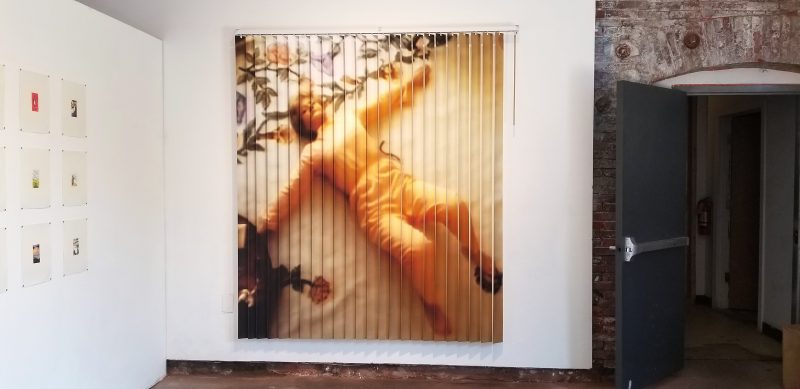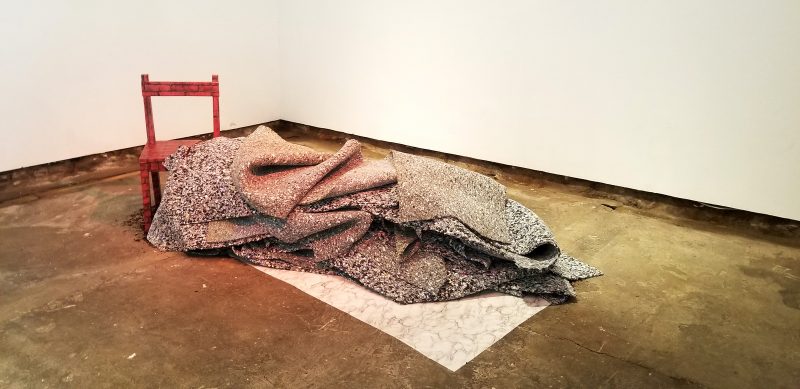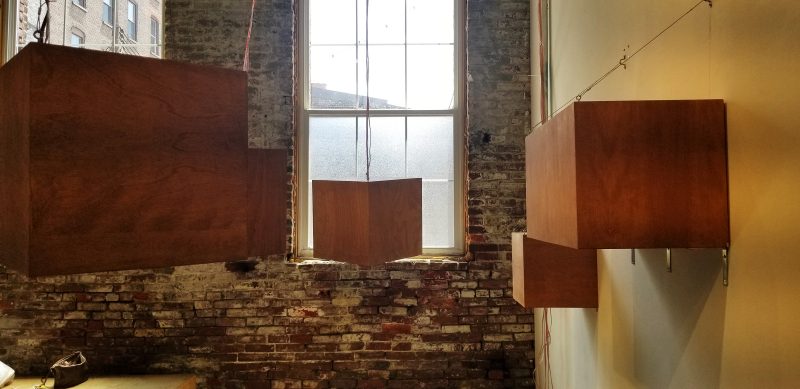What is the desire to take up more space than we are allowed to have? There’s a lot of politics around space and who can be loud and large in it without punishment and who must make themselves small. Western art history has fixated on the idea of art as a useless object and its ability to exist boldly without utility. In this current moment how are artists reconciling their privilege as “space-takers” and the failings of a Western, ars gratia ars, mentality?
Little Berlin’s latest show is not based around a theme or concept but around size. On view until August 26th, Big Boys features large scale works from seven artists: Brice Peterson, Bridget Purcell, Dani Dobkin, Danielle deLeon, Jacqueline Willoughby, Kate Schneider, and Mirra Goldfrad. The artists were selected from Little Berlin’s most recent open call and were curated by the collective. I was curious what kind of snapshot of large scale work Big Boys would offer and how smaller cultural institutions, like Little Berlin, use humor and creativity in their open calls as a mode of engagement.

What may be surprising about Big Boys is that, well, the work is not extremely big. The works are not about dwarfing the viewer or the inflation of objects beyond their reasonable size. In fact, the pieces in the show tend to be very domestic is size and in content — chairs, blinds, tables, shelves. A sculpture by Brice Peterson exemplifies this quality: a set of blinds with printed surfaces that now hold an image of Angela Lansbury laying on the floor. Peterson explores a popular form of image making that combines online customization and media nostalgia. Household objects become shrines with the right sized printer.
A sculpture by Mirra Goldfrad is composed of large folds of carpet padding sitting on top of vinyl floor tiles. The padding reaches and overlaps the corner of a chair that has brick patterning adhered to its surface and what looks like tobacco sprinkled on its seat. Goldfrad visually ties these objects together with a single pink light that washes the piece in a rosy tone. The resulting play of warm light and cool shadows brings beautiful visual cohesion to the work.
Like Peterson and Goldfrad, Jacqueline Willoughby also uses scale and found objects to depict an alternate home space. Her work, a large white fountain-like base topped by table made from wire mesh, also translates materials. The artists’ shifting of surface and materiality shows a desire to modify the everyday into a specific personalized aesthetic and vision of the home.

By contrast, Kate Schneider’s work observes the personal aesthetics of many other individuals. Her series of 30 colored pencil drawings are of images taken from friends’ Instagram stories. Each drawing is slightly smaller than a smartphone screen but, the proportions are unmistakable. Though the individual drawings are far from big, together they present a compelling survey of the images people capture when image capturing is possible at nearly every moment. The labor of collecting and depicting 30 photos is notable.
Dani Dobkins further pushes focused individualistic experiences by suspending five cubes with empty bottoms so viewers may stick their head inside of them and hear the various audio tracks of light percussion and chimes. Together the five cubes take up enough space for the viewer to weave between them and listen to the forest of sounds, but the value of the works comes from the singular, confining interactions.

Unfortunately it’s hard to tell exactly what Little Berlin’s members’ intentions were in the curation of this show. And my frustration with the lack of curatorial conviction is exacerbated by the original name of the show, “Big Boiz.” After attention was brought to the appropriative nature of the name, “boiz” being a word used primarily by black queer folks, it was changed and an apology was made. The original name was supposed to be funny, in the way that often times people use slang as a punchline when they want to show they aren’t taking things too seriously.
The members of Little Berlin could have initiated a powerful conversation through Big Boys—perhaps one about the responsibilities an artist has once working at a certain scale, or the power of speculation in redesigning living and social spaces, or even the joyful absurdity of taking up space in the face of restriction. Arts organizations have a responsibility to delve into topics important for their visitors to examine. It doesn’t have to be serious but it should be considerate.
“Big Boys” is on view August 4-26, 2018, at Little Berlin, 2430 Coral St., Philadelphia, PA 19125









